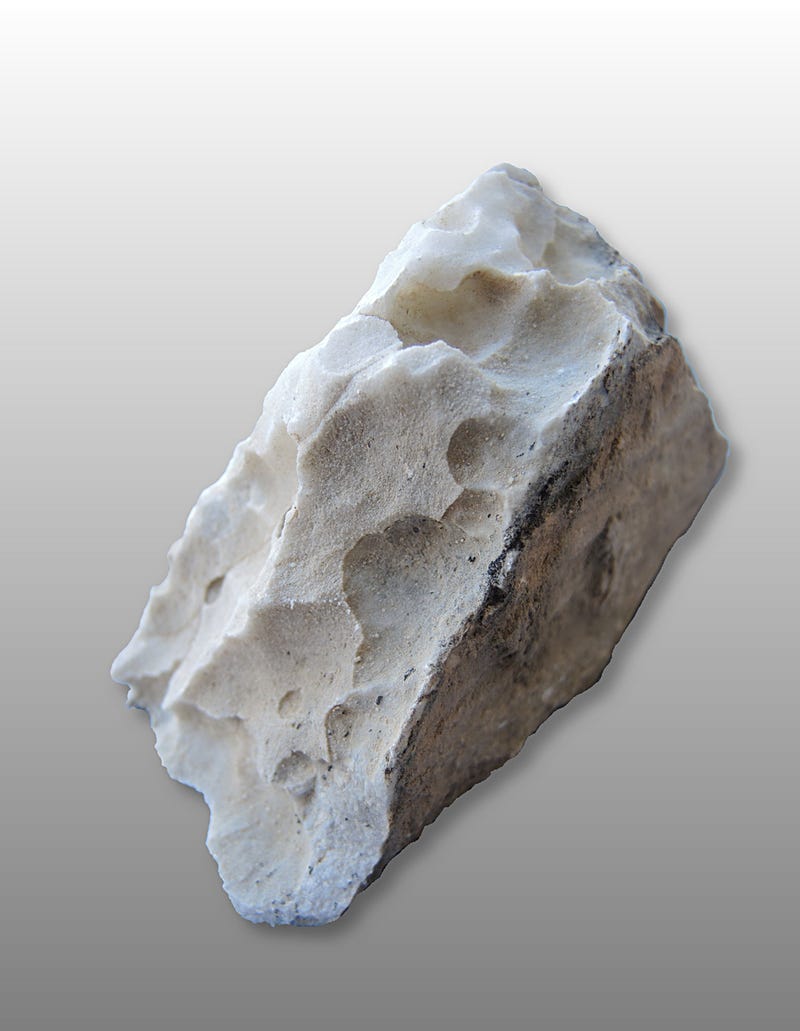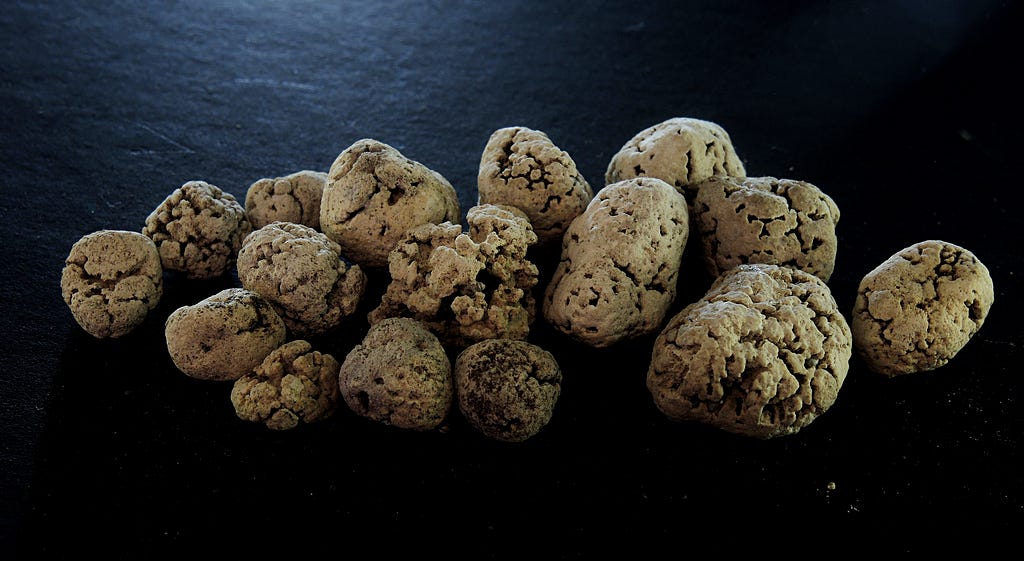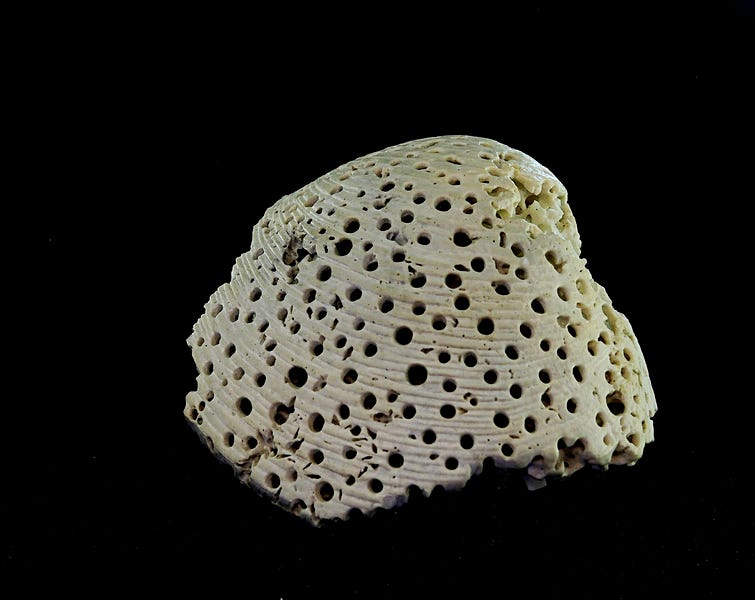Few elements on earth exist in their uncombined form, joining instead with other elements to form a seemingly infinite variety of different chemical compounds containing from two atoms to billions of atoms arranged in simple lines to complex nets, masses, sheets, or mutable sculptures that shift shapes in response to their environment. Carbon, the 15th most abundant element in the earth's crust is, of course, familiar in its role as the basis of life, its four bonds capable of forming the molecules of living things. In this role, the element carbon cycles between the world of organic life and its gaseous, oxidized form, carbon dioxide. As practically everyone now knows, carbon dioxide regulates earth’s climate by capturing infrared light from the sun and warming the atmosphere. When the concentration of the carbon dioxide in the atmosphere increases, the atmosphere gets warmer. When carbon dioxide is removed from the atmosphere by incorporation into organic matter through photosynthesis, or dissolved in the ocean for longer term storage, the climate cools. These changes occur on a time scale of decades to centuries.
Calcium and Carbon in Linked Cycles: But there is another element tangled up in this web of chemical and physical reactions, and that is calcium. Calcium, the 5th most abundant element in earth's crust, can also combine with carbon dioxide, forming calcium carbonate (limestone) a solid compound of low solubility, and thus capable of removing carbon dioxide from the atmosphere and the water. But there is a tricky wrinkle to this process, which is that the solubility of calcium carbonate depends on the pH or acidity of the water--- greater at higher acidity and lower when more alkaline. Carbon dioxide, in addition to being a component of calcium carbonate, when dissolved in the water, renders water more acidic and thus more capable of dissolving limestone. It is thus involved both in forming and dissolving limestone. Other sources of acids, such as the products of organic decay, act similarly. This phenomenon is visible wherever limestones are exposed to rain. Because the erosion is chemical rather than physical abrasion, it sculpts the limestone into scalloped and often sharp forms, even dissolving holes here and there. The Edwards Plateau of Texas has many areas with soil so thin that the bedrock is exposed directly to solution erosion by rain. I couldn't resist collecting a few pieces of this fantastic sculpture to add to my Found Objects collection.
But limestone is not permanent and immutable. Under great heat and pressure deep in the earth, limestone is metamorphosed into marble, but when exposed at the surface, marble is also subject to solution by acidic rainwater. High in the Santa Rosa Mountains of the Anza-Borrego Desert, on top of massive granite intrusions are bands of pale to white rock strata, visible from ten miles away. These are 450-million-year-old layers of limestone transformed into marble during the intrusion of granite. Where this marble is exposed to the scarce rains of the desert, it too dissolves away, leaving stone with a gently scalloped surface. Collecting this specimen meant a strenuous five-mile, 5000 feet climb to the marble strata.
Algae and Plants in the Cycle: When water becomes less acidic (more alkaline), it is less capable of holding dissolved calcium carbonate, depositing it as solid layers of stone. The simplest way of losing acidity is for the dissolved carbon dioxide to be removed from the water, either by simply diffusing into the atmosphere, or by being used up by photosynthesizing plants or algae. I found a tiny example of this part of the carbon-calcium cycle in Tubb Spring, located at 2500 feet above sea level in the San Ysidro Mountains in the Anza Borrego Desert State Park. Like most desert springs, the quarter mile run of Tubb Spring was overgrown with a thicket of willow, cat tail, rushes, and other water-loving plants, along with a few sycamore trees. I had often fought my way through the thickets to the few pools of open water with their watercress, filamentous algae and monkey flowers.
But a few years ago, a fire burned tens of thousands of acres of mountain chaparral, including the area around Tubb Spring. Suddenly, all the thickets and trees were gone, and the bare ground lay there for all (at least me) to see. Where there had been a patch of cattails on a slope, the seep that had sustained the cattails now lay exposed, a thin layer of water flowing slowly down the slope over the sandy soil. In this water lay hundreds of little, rounded pebbles that looked completely out of place in this sandy location. Picking some up, I saw the greenish surface and the "mini-canyons" that fissured the surface of these pebbles. These were algae-made pebbles formed because of algal growth. As the algae extracted carbon dioxide from the calcareous seep water during photosynthesis, the water became more alkaline, causing layer upon layer of limestone to deposit on the growing pebbles.
The same process caused the formation of pillow-like rocks in the shallow waters of Pyramid Lake in the Nevada desert. Algae growing on the rock surface extract the carbon dioxide during photosynthesis, causing the deposition of calcium carbonate layers, like stromatolites in the earth’s earliest oceans.
In the deeper waters of the lake, algal deposited tufa forms underwater towers over mineral laden springs, to be exposed as the lake slowly dries and shrinks (https://waltertschinkel.substack.com/p/bygone-beaches). Some of these exposed towers stand 50 feet tall, far from the current shore, and when broken, expose the radial prisms formed during their growth.
Animals and the Acid-Base Game: This delicate balance between solid and solution is exploited by shell-forming mollusks when their mantle tissue shifts the pH toward alkalinity, thus depositing solid calcium carbonate as a growth layer to the shell. Growth is usually not continuous but occurs on a daily, lunar, tidal, or more complex cycle, creating visible growth lines in the shell (https://waltertschinkel.substack.com/p/counting-the-days). To protect the calcium carbonate from re-solution, the mollusk secretes a tough protein to cover the outer surface.
But this balance is delicate and sensitive to small changes in pH. One of the concerns stemming from the increase in atmospheric carbon dioxide is that increased dissolved carbon dioxide in the ocean makes the water more acidic and shifts the equilibrium toward solution, thereby decreasing the ability of shell-forming animals to secrete shells.
The effect of acidic water on mollusk shells is very visible in the brackish marshes of the Florida Gulf Coast. Water running off the swampy land is quite acidic because it contains humic acids derived from the partial decay of plant material under the nutrient-poor conditions of the wetlands. Marsh clams (below), like all mollusks, protect their surfaces against solution with a tough protein coating, but wherever this protective coating is broken, the acidic waters slowly dissolve the shell away, sometimes even to the point of perforation. The clam pays a price for living in such acidic, brackish water.
The same acid-base chemistry allows some creatures to bore holes in the shells of mollusks. That this is a chemical process rather than a physical one becomes clear when we learn that sponges are among the most proficient borers of shells, riddling clam and other mollusk shells until they look like Swiss cheese (below). The sponge’s tissues live within these protected solution cavities. In the process, boring sponges return calcium carbonate to soluble form to be re-used by other creatures.
Making Limestones. Most limestones are formed biologically by the thousands of species of animals that make limestone shells, skeletons or homes, or by algae that deposit limestone in the course of photosynthesis. When these creatures die, their shells or skeletons accumulate on the bottom of seas to become limestones or chalks. Corals expand as clones of polyps that live in limestone cups secreted by their outer tissue that continually deposits limestone under themselves so that the coral grows outward and upward indefinitely as sheets, heads or branching structures (see below), given they are not broken off by a storm or killed by a predator. Their many species can form huge reefs that are sometimes fossilized into entire mountain ranges such as the Guadalupe Mountains of New Mexico. Between shelled animals and corals, vast amounts of both calcium and carbon dioxide are thus removed from the atmosphere and stored in limestones.

When seas become supersaturated in calcium carbonate, limestone can form without the intervention of living things by deposition around nuclei of sand or debris to form small, egg-shaped pebbles that become cemented into oolitic limestone. Drying seas can also deposit calcium carbonate in large amounts.
Carbon and Life: Clearly then, the carbon dioxide that regulates atmospheric temperature is part of two linked cycles, each of which can remove vast amounts of carbon dioxide from the atmosphere, cooling the climate. Over the moderate term of decades to centuries, the living world, past and present, creates a steady state relationship between plant organic matter and atmospheric carbon dioxide. When the carbon in plants is deposited as fossil fuels such as oil or coal, it is removed from the living system over millions of years. Of course, when this fossil carbon is burned, the return of all that ancient carbon to the atmosphere as a greenhouse gas leads to a warming climate.
Carbon in Rocks: But in addition to carbon in the biosphere and fossil fuels, enormous amounts of carbon are held in long-term repositories as calcium carbonate in a range of rock and mineral types. Is this carbon also part of the carbon-dioxide-driven climate cycle? Can a significant fraction of the carbon in carbonate rocks be returned to the atmosphere as carbon dioxide? The answer is yes, but the process involves much more time and much more than the thin skin of life on the earth's surface. It involves the contortions of the earth itself, the stirring of its mantle, the formation of sea floor and the movement of the continents.
From Rocks to Carbon Dioxide and Back: On a scale of millions of years, continental rocks are weathered, and the calcium thus liberated is eventually deposited as carbonate rocks formed from the shells of animals or through chemical precipitation. Here it can remain for millions of years. Much of this occurs in shallow seas at continental margins, but continents are sheets of lighter rocks floating on the denser rocks of the sea floor, and sea floor is constantly being formed by the upwelling of semi-fluid rocks on rising mantle plumes at mid-oceanic ridges. Where this outward spreading sea floor bumps into continents, it often slides under the continents (subduction), dragging the carbonate rocks under with it. Tremendous heat and pressure on its way down cooks off the carbon dioxide from the carbonate rocks, and vents this gas to the atmosphere through volcanoes, warming the climate.
At least two past extinction events have been attributed to runaway warming following eras of massive volcanic eruptions. But in the process of cooking off carbon dioxide, the acidic carbonate-rich rocks are converted into basic (alkaline) silicate-rich rocks that are incorporated into the mantle. Mantle circulation eventually moves some these basic silicate rocks to the mid-ocean ridges and injects them into the sea floor.
Occasionally, continents collide so violently that they push these basic, silicate-rich, sea-floor rocks onto the margins of continents and to form mountains (so-called ophiolites). This exposes the basic mantle rocks to atmospheric weathering, a process that consumes carbon dioxide and converts the basic, silicate-rich rocks into acidic, carbonate-rich rocks once again. This removes vast amounts of carbon dioxide from the atmosphere and cools the climate.
This process proceeds much faster when the ophiolites occur in the warm, humid tropics. The most recent large such ophiolite-driven cooling is thought to be the Andean, southeast Asian and Indonesian island arcs, and is thought to be the cause of the series of quaternary ice ages of the last 2.5 million years. The recent and currently active tropical ophiolites are shown in purple below. The weathering of these tropical mountains is currently removing huge amounts of carbon dioxide from the atmosphere, reducing greenhouse warming.
More Geology and Climate: Recently, an additional geological factor in ice age cooling has been proposed, one that is again associated with the movement of tectonic plates. Tectonic plates (i.e. continental crust) are moved by the formation of new seafloor crust when basalts are injected at the mid-oceanic ridges. In addition to spreading the seafloor crust, this volcanic process also releases residual carbon dioxide that was incorporated in the surface cycles, but not completely cooked off during subduction. This carbon dioxide first enters the ocean and then the atmosphere where it can affect the climate. Logically, the size of this climate effect must be related to the rate of seafloor spreading. Can that rate be estimated?
Fortunately, it can, using magnetometers. When molten magma solidifies after injection at the mid-oceanic ridges, the magnetic dipoles of its contained minerals are set by the current direction of the earth's magnetic field. But the direction of this field flips every few million years, creating magnetic stripes of opposite polarity in the ocean floor that move slowly and symmetrically outward from the mid-ocean ridges toward the continents, and are detectable from a magnetometer dragged behind an airplane or a ship. Strips on opposite sides of the mid-oceanic ridge are symmetrical with respect to age.
The stripes closer to the mid-ocean ridges were narrower that those further away. If the earth's magnetic poles flip more or less regularly, this suggests that the rate of seafloor spreading, and therefore the rate of new carbon dioxide injection into the ocean-atmosphere system have decreased in the last several million years. The combination of the removal of carbon dioxide by ophiolite weathering, and the decreased injection of new carbon dioxide by slower seafloor spreading, lead to lower atmospheric carbon dioxide to such a degree that a series of ice ages followed. Science being what it is, this is probably not the final answer either.

It pleases me that my little Found Objects and I are tiny parts of something vast and complex in both time and space. They remind us that everything in the world has an origin and a history extending backward in time, and forward into the future. Perhaps just rocks and mundane detritus, but to me, my Found Objects are packed with meaning--- charming, small snapshots and brief moments in something unimaginably grand and ever changing. How could it be otherwise when a clam making its shell is connected to sea floor spreading and earth climate?












Ray, Average ocean pH has increased by about 0.1, from a pre-industrial pH of about 8.16 to a current pH of 8.07, still slightly basic (https://www.epa.gov/ocean-acidification/understanding-science-ocean-and-coastal-acidification). Atmospheric CO2 has increased about 40%. I am not sure how to understand "a third more acidic." Converting the pH to hydrogen ion concentration (pH is a log function), I calculate that there has been an increase of 25% in that concentration. Maybe that's what you meant. In relation to shell deposition, as the pH become lower (more acidic) the equilibrium between solid and dissolved calcium carbonate is moved toward higher solubility, making it more difficult to deposit as shell.
I think we need to separate two different rates that affect CO2 concentrations. One is the rate of addition by the burning of fossil fuels, deforestation,etc., and the other is the rate of CO2 removal by the weathering of basic rocks. Because the first rate is currently (and unnaturally) very high, it overwhelms the rate of removal by weathering, and we get the observed increase in atmospheric CO2. As far as I know, the geological process of weathering has been little affected by human activity. Perhaps my account didn't make these rate differences clear.
Lovely, graceful lessons. Thank you for including us in the list.
Eric